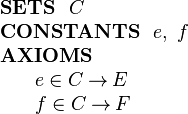Structured Types: Difference between revisions
From Event-B
Jump to navigationJump to search
imported>WikiSysop |
imported>WikiSysop |
||
| Line 2: | Line 2: | ||
The Event-B mathematical language currently does not support a syntax for the direct definition of structured types such as records or class structures. | The Event-B mathematical language currently does not support a syntax for the direct definition of structured types such as records or class structures. | ||
Nevertheless it is possible to model structured types using projection functions to represent the fields/ attributes. For example, | Nevertheless it is possible to model structured types using projection functions to represent the fields/attributes. For example, | ||
suppose we wish to model a | suppose we wish to model a record structure 'C' with fields 'e' and 'f' (with type E and F respectively). | ||
Let us use the following syntax for this (not part of Event-B): | Let us use the following syntax for this (not part of Event-B): | ||
| Line 9: | Line 9: | ||
{{SimpleHeader}} | {{SimpleHeader}} | ||
|<math> \begin{array}{lcl} | |<math> \begin{array}{lcl} | ||
\textbf{ | \textbf{RECORD}~~~~ C &::& e\in E\\ | ||
&& f \in F | && f \in F | ||
\end{array} | \end{array} | ||
| Line 35: | Line 35: | ||
Now, given an element <math>c\in C</math> representing a record, we write <math>e(c)</math> for the 'e' component of structure | |||
'' | |||
Revision as of 16:03, 1 May 2009
Modelling Structured Types
The Event-B mathematical language currently does not support a syntax for the direct definition of structured types such as records or class structures. Nevertheless it is possible to model structured types using projection functions to represent the fields/attributes. For example, suppose we wish to model a record structure 'C' with fields 'e' and 'f' (with type E and F respectively). Let us use the following syntax for this (not part of Event-B):

|
We can model this structure in Event-B by introducing (in a context) a set  and two
functions
and two
functions  and
and  as constants as follows:
as constants as follows:

|
Now, given an element  representing a record, we write
representing a record, we write  for the 'e' component of structure
for the 'e' component of structure